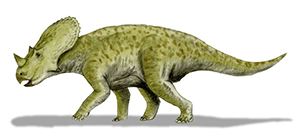Brachyceratops montanensis Gilmore, 1914

(Da: it.wikipedia.org)
Phylum: Chordata Haeckel, 1874
Subphylum: Vertebrata Cuvier, 1812
Classe: Dinosauria Owen, 1841
Ordine: Ornithischia Seeley, 1888
Famiglia: Ceratopsidae Marsh, 1890
Genere: Brachyceratops Gilmore, 1914
Descrizione
Il brachiceratopo era un dinosauro quadrupede, erbivoro, conosciuto per resti appartenenti ad animali giovani; appartiene al gruppo dei ceratopsi, o dinosauri cornuti, e come tutti i suoi simili era dotato di un collare sviluppato nella parte posteriore del cranio. Le corna, data l'età immatura degli esemplari finora rinvenuti, erano poco sviluppate. Questo dinosauro potrebbe essere stato molto simile a forme più conosciute come Centrosaurus o Einiosaurus. I resti appartenenti agli animali più giovani non sono però attribuibili con certezza ad alcuna forma nota né possono essere considerati un genere a sé stante. Un cranio appartenuto a un subadulto, però, sembrerebbe essere una specie valida. Il collare è molto ampio, sottile e manca delle solite finestre, caratteristiche queste di centrosaurini giovani; altre caratteristiche, invece, sembrano avvicinarlo a Einiosaurus (la presenza, ad esempio, di nodosità sul margine del collare).
Diffusione
Era un dinosauro cornuto vissuto nel Cretacico superiore del Montana (USA).
Bibliografia
–Ryan, Michael J.; Holmes, Robert; Russell, A.P. (2007). "A revision of the late Campanian centrosaurine ceratopsid genus Styracosaurus from the Western Interior of North America" (PDF). Journal of Vertebrate Paleontology. 27 (4): 944-962.
–Andrew T. McDonald & John R. Horner, (2010). "New Material of "Styracosaurus" ovatus from the Two Medicine Formation of Montana", In: Michael J. Ryan, Brenda J. Chinnery-Allgeier, and David A. Eberth (eds), New Perspectives on Horned Dinosaurs: The Royal Tyrrell Museum Ceratopsian Symposium, Indiana University Press, 656 pp.
–"Brachyceratops." In: Dodson, Peter & Britt, Brooks & Carpenter, Kenneth & Forster, Catherine A. & Gillette, David D. & Norell, Mark A. & Olshevsky, George & Parrish, J. Michael & Weishampel, David B. The Age of Dinosaurs. Publications International, LTD. p. 133. ISBN 0-7853-0443-6.
–C.W. Gilmore, 1914, "A new ceratopsian dinosaur from the Upper Cretaceous of Montana, with note on Hypacrosaurus", Smithsonian Miscellaneous Collections 63(3): 1-10.
–Dodson, P., 1996, The Horned Dinosaurs - A natural history, Princeton University Press, p. 154.
–C.W. Gilmore, 1917, "Brachyceratops, a ceratopsian dinosaur from the Two Medicine Formation of Montana, with notes on associated fossil reptiles", United States Geological Survey Professional Paper 103: 1-45.
–Gilmore C.W. 1939, "Ceratopsian dinosaurs from the Two Medicine Formation, Upper Cretaceous of Montana", Proceedings of the United States National Museum 87: 1-18.
–Sampson, S.D., M. J. Ryan, and D. H. Tanke. (1997). "Craniofacial ontogeny in centrosaurine dinosaurs (Ornithischia: Ceratopsidae): taphonomic and behavioral implications." Zoological Journal of the Linnean Society, 121: 293-337.
–McDonald, Andrew T. (2011). "A Subadult Specimen of Rubeosaurus ovatus (Dinosauria: Ceratopsidae), with Observations on Other Ceratopsids from the Two Medicine Formation". PLOS ONE. 6 (8): e22710. Bibcode: 2011PLoSO...622710M.

|
Data: 30/03/2018
Emissione: Dinosauri Stato: Sierra Leone Nota: Emesso in un foglietto di 4 v. diversi |
|---|